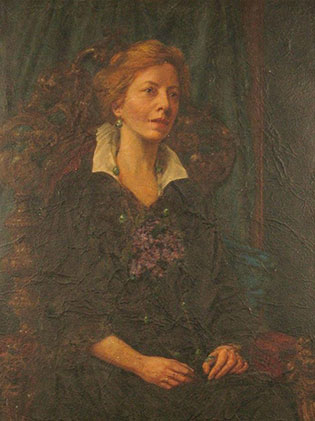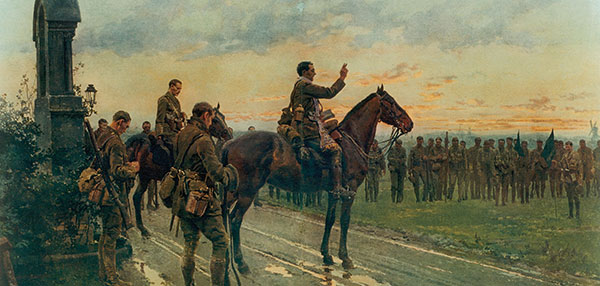Louie Rickard—the inspiration behind ‘The Last General Absolution of the Munsters at Rue-du-Bois’?
Published in Features, Issue 6 (November/December 2019), Volume 27By John Hayes

Above: Matthew Webb’s 1916 portrait of Louie Rickard. (Dublin City Gallery: The Hugh Lane)
During the centennial commemorations of the First World War, the illustration entitled ‘The Last General Absolution of the Munsters at Rue-du-Bois’ by the war artist Fortunino Matania often appeared. The image depicts the administration of the sacrament of penance to the second battalion of the Royal Munster Fusiliers by their chaplain, Fr Francis Gleeson, under the command of Lt. Col. Victor George Howard Rickard (each on horseback). This was just before the battalion took up its trench position on 8 May 1915, relieving the 1st Coldstream Guards. Rickard (b. c. 1873) died with one sixth of his men the following morning in the Battle of Aubers Ridge, a disastrous military failure. The image was probably inspired by Col. Rickard’s wife, née Jessie Louisa Moore (b. 1876).
Louie, as she was known familiarly, was the daughter of Canon Courtenay Moore (1840–1922), incumbent of the ancient parish of Brigown in Mitchelstown, Co. Cork, from 1882 to 1916. The Antrim-born canon was an active antiquarian, editor of the Irish Ecclesiastical Gazette (1893–7), a Home Ruler, Irish-language advocate and novelist, who wrote an engaging account of his long service in the diocese of Cloyne. On his retirement, the Roman Catholics of Mitchelstown presented him with a ‘handsome illuminated Address’ to mark his contributions to life there. His daughter early developed a literary bent. Still in her teens, she contributed hunting stories to the Cork Examiner. In 1901 she married an army officer, Robert Dudley Innes Ackland, to whom she bore a daughter in 1903.
Louie, however, filed for divorce from Ackland; this was granted on 10 February 1908. (Ackland was later one of the last casualties of the Gallipoli campaign, dying on 6 January 1916.) Louie’s marriage to then Capt. Rickard was announced in the Irish Times (10 March 1908) as having ‘taken place quietly at Tralee this month’. Subsequently, the Rickards went to the Adaman Islands, where the Munsters were then based. In 1913 a son, Victor Justin Rodney Rickard, was born. The year after Rickard died in battle, Louie married for the third time, again to an army officer, Lt. Col. Tudor Fitzjohn (1875–1962), in Oxfordshire. This marriage did not last either and was certainly irretrievably broken long before a divorce in 1935.
In the aftermath of Victor Rickard’s death, his wife, by then a published novelist, seems to have been mainly occupied with memorialising his sacrifice. The first of what were to be four articles by her on the war experience of the Munster Fusiliers appeared on 10 July 1915 in New Ireland—a weekly review edited by Denis Rolleston Gwynn (a great-grandson of William Smith O’Brien). The first article was devoted specifically to the Aubers Ridge action. All four articles were reprinted in 1916 in the London magazine The Sphere, a publication to which Matania contributed a weekly image. A colour version of the Matania illustration appeared in The Sphere later that year (27 November 1916). Meanwhile, New Ireland published a 55-page booklet containing all the articles in September 1916. Augmented by new material, Mrs Rickard’s book The story of the Munsters at Etreux, Festubert, Rue du Bois and Hulloch was published in London in 1918, and was followed by three popular war novels.

Above: ‘The Last General Absolution of the Munsters at Rue-du-Bois’ [8 May 1915] by Fortunino Matania. It is probable that Matania based his illustration on Louie Rickard’s articles on the war experiences of the Munsters, originally published in the New Ireland weekly review and later reprinted in the London magazine The Sphere, to which Matania contributed a weekly image. A colour version of the illustration appeared in The Sphere on 27 November 1916. (NMI)
After the war, Louie lived in London—in Chelsea—and enjoyed a circle of prominent Irish friends, including, for example, Fermoy-born Mrs Josephine McNeill, wife of the Irish high commissioner in London. Mrs Rickard and her daughter were listed among the ‘Ladies Present’—along with Countess Markievicz, Mrs Maud Gonne MacBride and Mrs Paul [Grace] Henry—in a report in the Freeman’s Journal (27 January 1922) of a reception in Paris organised by Seán T. O’Kelly as part of an Irish Race Conference, aimed at gaining international recognition for the new Irish Free State. Louie formed a close friendship with Hazel, Lady Lavery, wife of the society painter, on whom she based a novel, A bird of strange plumage (1927). In 1925 she and Hazel converted to Roman Catholicism, instructed by a Vincentian priest, Fr Joseph Leonard, better known now for his correspondence with Mrs Jacqueline Kennedy. Louie published a great number of books—mainly light comedy, adventure and detective novels. In 1930 she joined the ‘Detection Club’. Other new members that year included G.K. Chesterton, Agatha Christie, Ronald Knox, A.A. Milne and Dorothy L. Sayers. Her publication output—approximately one novel per annum—continued until Murder by night in 1936, after which it declined.
In 1946 Louie came to live in Cork city—the locale of her last novel, Shandon Hall (1950). In 1950 she suffered a stroke that paralysed her right side. An old friend, Denis R. Gwynn, Professor of Modern Irish History in UCC, then invited her to stay in his Montenotte home. In her memoir Elizabeth Bowen: portrait of a writer (1977), Victoria Glendinning quoted the historian C.V. Wedgwood, who wrote that Gwynn lived ‘in blameless devotion with a late-Victorian femme fatale, now nearly 80, and still incredibly the beauty and toast of Munster’. She added, with some exaggeration, that Louie ‘ran through an astonishing number of husbands on both sides of the Irish Channel, before settling to this charming and platonic attachment’.
Louie died in 1963 and later that year, in a move that caused a frisson in Cork society because of the disparity in age, Denis Gwynn married Alice Trudeau, a daughter of Hazel Lavery by her first husband, Ned Trudeau. In his will Gwynn returned the compliment of a previous generous bequest by Louie Rickard by leaving £4,000 to her son, Victor Rickard.
Prof. John Hayes was formerly Dean of Arts at Mary Immaculate College, Limerick.
Read More:
FURTHER READING
J. Hayes, ‘An icon of sacrifice: “The Last General Absolution of the Munsters”’, North Munster Antiquarian Journal55(2015), 89–111.
C. Moore, A chapter of Irish church history: being some personal recollections of life and service in the Church of Ireland (Dublin, 1907).
















